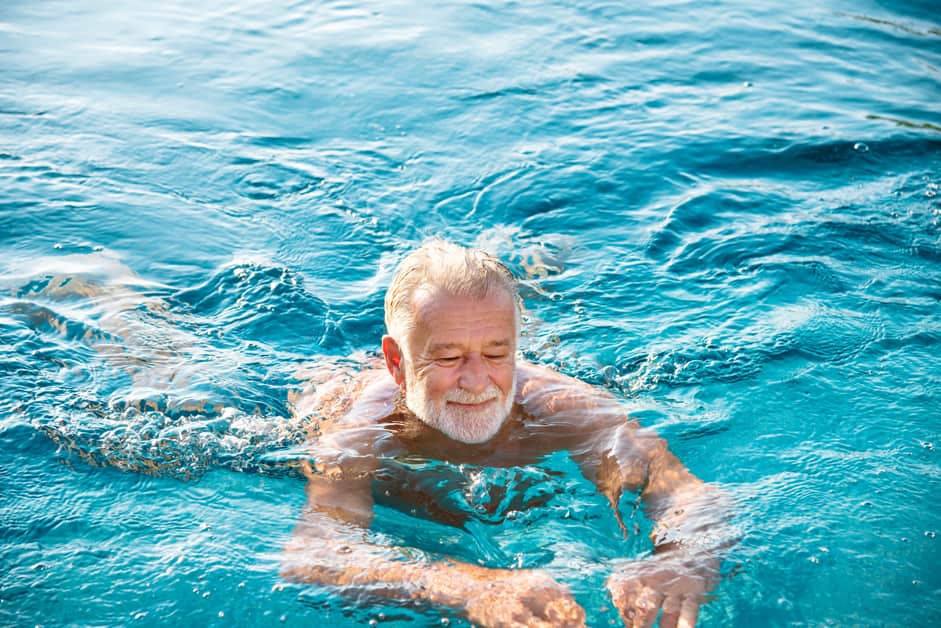Introduction
Gout is a type of arthritis caused by too much uric acid. This makes the joint around the big toe, ankle, and knee swell and hurt. The pain can limit our range of movement and make exercising risky. But there are ways to combat this! Low impact exercises can help reduce or even eliminate the pain, whilst keeping you active.
This article will explain the best exercises for gout knee pain relief. We have picked simple movements that can be done at home, yet are still effective. Plus, you will get professional advice on running with gout, and tips on preventing it.
Low-Impact Exercises for Gout Knee Pain
Knee pain from gout? Ouch! Running and walking can be hard. But, low-impact exercises can help reduce the pain. This article will tell you about the best exercises.
- Low-impact cardio,
- stretching,
- and strength-training
are all good options. They are safe and can help manage the pain.
Walking
Walking is great exercise for relieving gout arthritis knee pain. It gives you moderate-intensity physical activity and helps improve strength and range of motion. It also reduces pain and inflammation.
When walking, use a heel-to-toe stride and keep a natural posture. Wear comfortable shoes that support the feet. When increasing activity, start slowly and build up intensity gradually.
Cycling
Cycling is an awesome low-impact exercise for those with gout. It puts very little pressure on the knee joint, which is great for a workout without pain. Cycling is also great for improving heart health and building muscles too.
Make sure your bike seat is the right size and comfortable. The wrong size or an uncomfortable seat can increase discomfort. Watch tutorials or check out library books before you start cycling to get the best experience. And consider padded underwear if the cycling leads to any soreness.
Always ask your doctor about any questions you have regarding cycling and gout knee pain.
Swimming
Swimming is a perfect low-impact exercise for people with gout. It reduces inflammation and relieves pain. Being in waist-deep water, it takes the strain off your body’s weight-bearing joints. The buoyancy and resistance of water give an aerobic workout without overworking muscles and joints.
For gout sufferers, swimming has a big advantage: it increases blood flow throughout the body, reducing inflammation around tender areas quickly. It’s easy too, so anyone can give it a go! However, physical activity can worsen symptoms during a flare up. Therefore, listen to your body – if you need to rest or feel pain, take a break until it passes.
Yoga
Yoga has been around for centuries in many places. Recently, it’s even become popular in the U.S. It’s a gentle form of exercise that helps relax and strengthen the body. It does this through stretching and poses combined with breathing exercises. Though some postures can be painful, they can be modified as you improve.
Yoga is a great option for those with gout knee pain. It rebuilds strength with small movements, instead of putting pressure on the joints. Downward Dog and Half Moon are especially good for this. Plus, yoga encourages better posture. This takes pressure off the joints, which may already be painful from inflammation caused by gout.
Overall, yoga is a great way to manage gout knee pain. It builds strength while protecting joints from harm. If you want an effective way to help manage your symptoms safely, give yoga a try!
Tai Chi
Tai Chi is an old Chinese martial art that has been around for centuries. This meditative exercise includes many low-impact postures, and is often done slowly and rhythmically. It can reduce body inflammation, increase flexibility and muscle stamina, and help with balance and calmness. For people with gout knee pain, these movements can fortify joints and muscles, and offer long-term relief from the disease’s ache.
Doing Tai Chi outside or in natural surroundings can bring even more physical health advantages with fresh air and sunlight. When doing Tai Chi with gout knee pain, it’s important to warm up first and stop if any discomfort appears or symptoms become worse.
Benefits of Low-Impact Exercise
Low-impact exercises are a great option for those coping with gout knee pain. They can help ease discomfort, boost joint flexibility, and support total body wellbeing.
In this article, we’ll look at the advantages low-impact exercise brings, and the best exercises for gout knee pain in particular:
Improved mobility
Low-impact exercises offer a lot of benefits for people who have had a knee injury like gout. One of the best improvements is enhanced mobility. Doing these exercises regularly can help with range of motion in the joint and also increase flexibility, minimizing the chance of re-injury.
Individuals can also target certain muscle groups to build a personal exercise routine. This is great for focusing on muscles around the affected area. Low-impact exercises also help reduce pain – particularly if it’s caused by arthritis. The low strain on joints and muscles makes it great for those with gout in the knee. Plus, it helps to strengthen surrounding muscles, increasing stability during physical activity and protecting against further harm.
Reduced inflammation
Low-impact exercises can be great for reducing inflammation due to gout and knee pain. These activities are great because they lessen the strain on your joints without getting rid of exercise entirely. Experts say regular exercise is essential for good health, even with gout.
The Mayo Clinic recommends low-impact activities, such as walking, swimming, biking, and using an elliptical machine. Jacuzzi therapy can also help reduce inflammation and knee pain significantly. This type of exercise is gentle enough to reduce discomfort while still providing full range of movement to keep your joints healthy.
Cycling is a great way to relieve stress on your joints, while still getting a good workout. Because cycling isn’t as hard on lower body joints as walking or running, it’s a great low-impact option for people dealing with gout or knee pain. Swimming is also a good choice, as it utilizes all major muscles while being gentle on the joints. Aquatic therapy can help ease stiffness and improve flexibility if you have severe gout or joint issues.
Other low-impact options that may help improve mobility and reduce inflammation are:
- Yoga
- Pilates
- Tai Chi
- Stretching exercises
Improved balance
Tai chi, yoga, and Pilates are low-impact exercises. They can help with balance and coordination. Plus, they reduce stress and improve flexibility. People who do them often say they feel stronger and have better balance.
Improved balance can help people who have gout knee pain. It lowers the risk of falling due to better body awareness. Improved balance also helps posture and builds strength around the knee joint. This makes walking and stairs easier.
Tips for Safe Exercise
Exercising is essential to managing gout and knee pain. But, it’s important to find the right type of exercise. High-impact activities should be avoided since they can cause more damage. Fortunately, there are low-impact exercises that can help reduce pain and improve mobility.
Here are some of the top low-impact exercises for gout knee pain:
Wear supportive shoes
Exercising? Wear shoes that give support. Cushioning, stability and shock absorption are best for gout sufferers. Have the right socks on too – no blisters or chafing. Outdoors? Get trail shoes with good traction. Extra arch support? Invest in orthopedic inserts or insoles.
Wearing supportive shoes can help reduce inflammation and ease pain when exercising for gout knee pain relief.
Warm up and cool down
Warm-up and cool-down exercises are key to avoiding gout knee pain. Start with light activities, like walking or dynamic stretching, to heat up the body. Do this for 5 to 10 minutes before exercise. Afterward, static stretching or gentle activities can bring your body back to a calm state. This prevents soreness or stiffness after a workout. Plus, regular exercise reduces inflammation.
So, warm up and cool down and don’t forget to exercise daily!
Start slowly and increase intensity gradually
Gout and knee pain can be tough to manage. So, when exercising, start off slowly. If you do too much too quickly, it can cause flares or hurt your joints.
Focus on increasing flexibility, stability, and strength. Warm-up for 10 minutes with gentle movements. When ready, set realistic goals based on your pain level, and increase intensity gradually.
Exercise is great, but don’t forget to follow medical advice. Before beginning any new routines, talk to a healthcare professional, especially if you have any other chronic conditions.
Conclusion
Exercising with gout knee pain can be a challenge. High-impact exercises can cause irritation. But, following a few precautions, you can still benefit from physical activity. Try five low-impact exercises to find the one that suits you best:
- Swimming
- Aqua aerobics
- Tai chi
- Yoga
- Cycling
- The elliptical machine
- Light strength training
Exercising in warm water could help reduce pain by increasing circulation and restoring mobility.
Listen to your body and start slowly. If it becomes too painful, reduce intensity or time. If pain persists or worsens, speak to your doctor for guidance before continuing.
Frequently Asked Questions
Q1: What kind of exercises can I do for gout knee pain?
A1: Low-impact exercises like walking, swimming, and yoga can help reduce pain and discomfort from gout knee pain. These exercises can also help improve your range of motion, strength, and flexibility. It’s important to talk to your doctor before starting any exercise routine to ensure it’s safe for you.
Q2: Are there any other activities I can do to help with gout knee pain?
A2: Other activities like physical therapy, massage, acupuncture, and taking hot or cold baths can help reduce gout knee pain. It’s important to talk to your doctor before trying any of these activities to make sure they’re safe for you.
Q3: What activities should I avoid if I have gout knee pain?
A3: High-impact activities like running, jumping, and contact sports should be avoided if you have gout knee pain. Talk to your doctor to find out which activities are safe for you.





